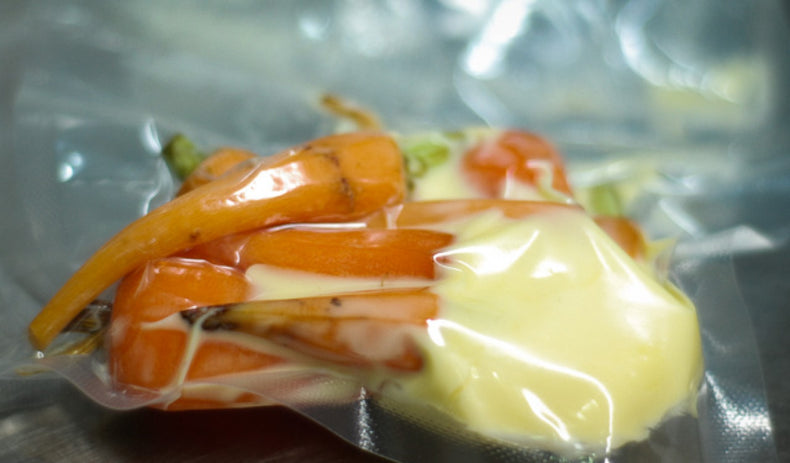Alyn Williams Discusses Vegetables And Sous Vide

“There was a boiled turnip, a boiled cauliflower, a boiled piece of fennel and a burned potato gratin on the plate. And that was it.” Alyn Williams laughs, describing one of the meals served to his vegetarian wife on holiday.
He’s laughing now, but this happened at a three Michelin-starred restaurant in New York. “There was no sauce, no garnish, no nothing – just boiled vegetables.” He sighs. “So I promised her that if I ever had my own restaurant, I'd pay more attention to the vegetarian menu.”
There was no sauce, no garnish, no nothing – just boiled vegetables.
Now that National Chef of the Year Alyn Williams has his name hanging above the door of the restaurant The Westbury Hotel in Mayfair, he has stayed true to his word. His seven-course vegetarian tasting menu flits from parmesan panna cotta to caramelised aubergines, to hop smoked potatoes and marsh samphire.
“We come up with dishes which aren’t just a garnish.” He says. “Too often, vegetarian dishes are the same as the fish or meat dishes – but without the fish or meat. All of the vegetarian dishes we serve are completely individual.”
“I sous vide more vegetables than I do meat and fish” Williams says, going against the argument that the sous vide technique is only worth using to tenderise tough meat. His reasoning is two-fold. Firstly, the compression that comes with vacuum sealing the vegetables, and also the strong flavours that comes from retaining and enhancing the vegetables’ juice.
“Usually the liquid in vegetables is inside small cells. By compressing them, you force the liquid throughout the fibres of the whole fruit or vegetable.” He explains. “If you imagine cutting into a watermelon, it’s got a grainy texture, with little uneven patches of colour. By compressing it in a vacuum sealer, it develops a uniform colour and denser texture, so it can be cooked without it disintegrating.” Williams says. “It doesn’t work with everything – a carrot, for example, has too much fibre. But it works really well on vegetables with more moisture, like marrows or onions. The colour, texture and taste is noticeably more even.”
When you’ve finished boiling carrots, you’re left with orange-coloured water containing the carrot flavours, which then gets thrown down the drain.
Williams explains how the methodology of cooking vegetables in a bag stops flavoured juices from leeching into the water they’re cooked in: “when you’ve finished boiling carrots, you’re left with orange-coloured water containing the carrot flavours, which then gets thrown down the drain.”
Not only does sous vide retain the vegetables’ natural flavours a lot more than boiling, but the this can be further enhanced by adding a spoon of freshly-squeezed juice before cooking. Williams does this in an industrial vacuum sealer which doesn’t suck out water with the air, but the technique can be replicated with home-use vacuum sealers if using a frozen cube of vegetable juice instead.
“Once a flavour is in the bag, then it will be transferred to the vegetable.” Williams explains. “So if I add a tablespoon of carrot juice to a few Chantenay carrots before they’re cooked sous vide, then I end up with a kind of supercharged vegetable.”
One of the most widely-debated aspects of sous vide cooking is the correct temperature, where as little as to 0.1C can change the outcome of a small piece of fish– but William’s approach with vegetables is far more laissez faire. His emphasis is on the process rather than the specifics. “What water baths do is give you more control. But when it comes to sous viding vegetables, the temperature sometimes doesn’t go high enough.” He explains. “If I’m sous viding potatoes to make a mash, then the maximum 90C isn’t high enough to break down the starch, so I put the vacuum bag of potatoes into a pan of boiling water on the hob instead. It still traps the flavours, stops water getting into the potatoes and cooks them perfectly.”
Golden turnips, white turnips, red beetroots, carrots, rainbow chard stems and cavolo nero on a ‘soil’ of trompette mushrooms and malt.
The result of William’s sous vide technique is beautifully-cooked, intensely flavoured vegetables. The dish that he uses to demonstrate this consists of golden turnips, white turnips, red beetroots, carrots, rainbow chard stems and cavolo nero. The vegetables are placed on a ‘soil’ made from trompette mushrooms and malt. The same mixture is dehydrated and crumbled on top of this beautiful ‘vegetable garden’. Although sous vide sceptics might mock the ‘boil in the bag’ technique, surely this should be enough to convert even the most cynical.


